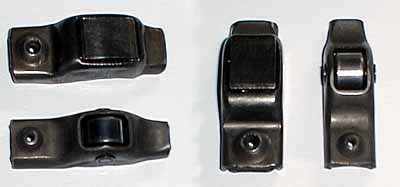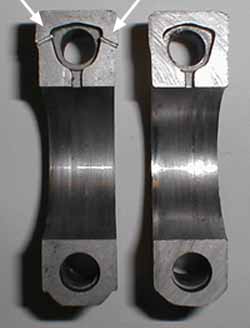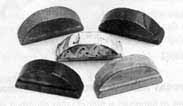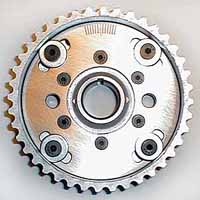
Camshafts,
Sprockets & Timing Belts
1984-1987 Turbo I/II PN: 4293819 .430 Lift 240-240 Duration 1988 Turbo I/II PN: 4387850 .430 Lift 236-232 Duration 1989-1992 Turbo I/II PN: 4387721 .430 Lift 228-228 Duration Mopar Performance "314" PN: P4529314 .460 Lift 240-240 Duration Forward Motion 475 PN: FM09034 .460 Lift Unknown Forward Motion 505 PN: FM-505 .505 Lift Unknown TAFT S1 (re-ground roller) Mild street Unknown
Unknown TAFT S2 (re-ground roller) S-60 replacement Unknown
Unknown TAFT S3 (re-ground roller) Full race Unknown
Unknown Mopar Performance Super 60 PN: P5249496 .499 Lift 260-260 Duration CompCams PN: 22-124-4 .499 Lift 268-268 Duration
(Note: the Comp cam and the S60 cam are the same.)
The best factory
cam according to the specs would be the 84-87 2.2 Turbo I/II camshaft,
it has the most duration of all the factory turbo cams. You
can run the later roller cams if you wish; they do have a little smoother
idle and make less noise but you will lose some duration and overlap (which
might not be a bad thing at high boost levels).
It's a drop in; just use the roller followers and it will work in any 2.2/2.5
engine. Lifters are the same and there is no need to change them.
Another bonus of the roller cam is reduced valvetrain friction- a whopping 75%
at idle and 35% at cruise!

FOLLOWERS ARE NOT INTERCHANGEABLE BETWEEN ROLLER AND NON-ROLLER CAMSHAFTS.
Another safety issue regarding slider cams- It looks like in late 1989 Chrysler discontinued machining the cylinder heads for lubricating slots that were needed for the slider cams. Since all cars after 1989 were equipped with roller cams this isn't a problem unless you are going to install an aftermarket slider camshaft.

Please
inspect your cylinder head to make sure the lubrication slots are present before
installing a slider camshaft! Premature camshaft wear will occur if they are
missing.
Aftermarket Cams
There are several aftermarket cams for the 2.2/2.5 turbo.
Mopar Performance has a .460 cam for the 2.2 Turbo but it seems to suffer from a high failure rate and general lack of power.
The Super 60/Competition
Cams was used in the S-60 package from Mopar- It's
power range is between 3000-6000 rpm. It
is good for 10hp on a bone stocker and on a modified engine is
worth 20-25hp. Specs: .499 lift, 260-268 duration.
NOTE: The power figures listed above are for engines
running 18 psi of boost or less- Engines running boost pressure in excess of 20
psi show better results using the factory roller cams.
Its drawbacks: Failure in emissions testing, low rpm operations with a heavy car, and very short life (10-18,000 miles).
Several fixes
are being tried to rectify this with no luck so far (several different
valve springs have been tried, stockers won't work). Competition Cams is
aware of the problem and is trying a few things to fix it... I know one
person who had the cam and followers Cyro treated and then dry filmed coated
and it still wore out in a very short time.
Forward Motion has an Inforcer cam with .460 lift (it's marked 475). Straight from Mike Demoss, owner of Forward Motion;
"This cam was designed mainly for improved driveability, which it does quite well. Off idle into boost the transition is much smoother. Over 4500 RPM the power advantage will be minimum."
I tried one in my Daytona-
In track testing at 25 psi of boost the car went faster and quicker with the
factory 89 roller cam! Same day, same car, same track. 3 passes with the FM cam,
3 passes with the roller.
TAFT is working on a number of roller grinds- Report by Steve Calder
Here are the dyno results (both objective and subjective) of the TAFT stage 2
and stage 3 roller cams versus a stock 89 turbo roller cam:
Test vehicle:
87 CSX, 89 2.2L common block, A568 trans, S60 electronics, FM big valve head, front mount Spearco, TAFT hybrid turbo, and some other small tricks;)
Ed's
note: Key things to note- displacement, head and turbo, in short an engine
suited for proper hi-rpm use.
Test methodology:
All tests were conducted with a wastegate setting of 14 psi. However, with the hybrid turbo the boost slowly creeps above 5200 rpm to a maximum of 17 psi. The
fuel was set very rich (1300 EGT) to prevent detonation (pump gas) and to provide enough fuel for potential increases in airflow due to the cams.
Nothing was changed but the cams, and each pull was initiated with similar water
and oil temperatures. Two pulls were completed for each cam to check for repeatability. Comparative numbers are taken from the second pull on each cam.
Each cam was run to 6500 rpm to check for trends in the power delivery.
Stock 89 turbo roller:
The stock cam produces 263.1 HP @ 5800 rpm and 256.2 lb.-ft @ 4600 rpm. The torque curve starts to drop quickly after 4600 rpm. Idle is very smooth and the
throttle response is extra crisp.
TAFT stage 2:
The stage 2 cam produces 272.2 HP @ 6000 rpm and 255.0 lb.-ft @ 4800 rpm. Below
3500 rpm the stage 2 cam sacrifices about 20 lb.-ft of torque. Between 3500 and
4500 rpm the torque curve approaches the stock curve and above 4700 rpm the stage 2 produces about 10
lb.-ft more torque. This translates into 10 additional HP at 4800 rpm which increases to 20 additional HP at 6500 rpm.
The idle remains smooth with a hint of lope (but much better than S60). Idle vacuum drops about 2 in-hg from the stock roller. Throttle response remains
crisp.
TAFT stage 3:
The stage 3 cam returns 327.0 HP @ 6700 rpm and 264.3 lb.-ft @ 5600 rpm. The rev
limiter kicked in at 6700 but the HP was still climbing steadily. Below 4000 rpm the stage 3 gives up 30
lb.-ft of torque. Between 4000 and 4700 the torque curve approaches stock, and above 4700 the curve demolishes the stock torque.
From 5500 rpm to 6700 rpm the torque curve is steady at 260 lb.-ft.
Idle with the stage 3 cam is approx. 4 in-hg less than the stock cam. The result was a large lope and some chop similar to the S60. The throttle response
showed some delay between input and response, but was fine above 2000 rpm.
Comments:
Cam selection and results are VERY dependent on the overall combination. The test combination is set up for high rpm airflow. In fact, it doesn't make full
boost until 3800 rpm. A mild combination probably would not respond as well to the stage 3 cam.
The overall results confirm the fact that more duration tends to move the torque
and hp peaks up in the powerband. Thus, for low end torque the stock cam is
best (Ed's note: Or for extremely high amounts of boost).
For more mid to top end
power the stage 2 is good, and for great top end power at the expense of low end the stage 3 works well.
Please feel free to contact me with any questions pertaining to the dyno results.
Steve Calder
From some readers...
Angelo Taylor's Turbo I powered L body-
The DC cam finally died so I put in an S60 cam.....the car did not like it AT ALL....it would now spark knock at only 9-10 psi of boost no matter what I did. My recommendations are: Do not run a S60 cam in a T1 car.....use the FM 475...
Another reader notes...
I used it as an opportunity to upgrade to FM's Enforcer 1 camshaft. It noticeably improved mid-range power, and also seemed to stretch out the top-end a little too, FM's 475 cam produces 14-16 inHg vacuum at a very smooth idle.
Mike Marra on the FM-475 camshaft...
However, with about 20,000 miles on it, MP sintered iron rocker arms, and MP valvesprings, it shows almost no wear. I give this cam much of the credit for my 13 sec TI.
I received an e-mail from a Shelby Dodge owner who is running two .475 cams.
It seems one of the cams is fine, the other has "gone away." The good one uses stock springs, the other, HD springs from Forward Motion. Stock springs seem to be the way to go then if you aren't running into valve float with the .475 cam.
I agree, the FM 475 cam works fine with the stock valve springs, seems to be the way to go!
If your planning on running BIG BOOST (25-30 psi) I find that cam selection seems to be less of an issue. It sounds strange but let me explain; In the K-car I didn't like the way the S-60 cam looked so I pulled it out and replaced it with a 89 roller cam. I fully expected to lose some MPH or ET at the track the next time I went racing and was amazed to see the car go 1 mph faster then it ever went before! If your running the high boost it seems that a larger camshaft may not be needed, indeed the larger cam maybe letting some hi-boost escape out the exhaust valve from the larger overlap of the camshaft design.
This had been noted on 2 cars running 30 psi of boost, in one case back to back runs were done the same day and the factory roller returned best ET'S and MPH'S of the day.
Relentless is running 10's on a factory roller cam!

PN: P4349650
Cam keys and adjustable cam sprockets are two ways to adjust your cam timing for maximum power. If you have had your head milled .20-.30 your cam timing will be 2 degrees retarded, you can either shim the head or reset the cam timing.

Shelby retarded the camshaft 4 degrees in the carburated Shelby Chargers with a special cam sprocket to make more high rpm hp. A multi keyway sprocket for 82-87 engines was sold through Mopar Performance but you have no way of telling where top dead center is! They forgot to mark TDC on the sprocket for 4 of the keyways.
1984-1988 "4201974"
Square tooth 2.2 Turbo, 2.2 N/A
1984-1987 "4201992"
Square tooth hi-output 2.2 N/A
1989-1992 "4387557"
Round tooth 2.2/2.5 Turbo, 2.2 N/A
1989-1993 "4448690"
Round tooth 2.5 N/A "common block"
1986-1987 "4273238"
Square tooth, "tall deck" 2.5 TBI ONLY
1988 .........
"4387535" Round tooth, "tall deck" 2.5 TBI ONLY
84-88 All 2.2 engines, Square tooth
............. (Gates p.n. T071)
86-87 2.5 tall deck, Square tooth
................. (Gates p.n. T114)
1988 2.5 tall deck, Round
tooth ................... (Gates p.n. T132)
89-93 All SOHC 2.2/2.5, Round tooth
......... (Gates p.n. T153)
91-93 2.2 DOHC 16V with Lotus head
........... (Gates p.n. T206)